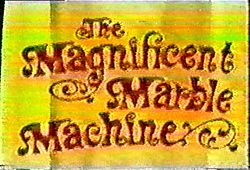- The Magnificent Marble Machine
-
The Magnificent Marble Machine 
Titlecard for The Magnificent Marble Machine.Format Game show Created by Merrill Heatter
Bob QuigleyPresented by Art James Narrated by Johnny Gilbert Country of origin United States Production Running time 30 minutes with commercials Broadcast Original channel NBC Original run July 7, 1975 – March 12, 1976 The Magnificent Marble Machine is an American television game show hosted by Art James and based on pinball. The show ran on NBC from July 7, 1975 to March 12, 1976, but was interrupted for two weeks in January due to scheduling changes on the network and aired repeats from March 15 to June 11. It aired in both half-hour slots between Noon and 1:00 PM, Eastern (11:00 AM/Noon, Central).
Merrill Heatter and Bob Quigley packaged this program, with Robert Noah as executive producer. Marble was one of two Heatter-Quigley game shows without Kenny Williams as announcer (the other being Temptation, which was also hosted by Art James). Because Williams was so busy at the time on the other H-Q shows (High Rollers, The Hollywood Squares, and Gambit totaling some 17 half-hours per week on networks and in syndication), Johnny Gilbert would be behind the microphone.
Contents
Gameplay
Two contestants (one a returning champion) competed, each paired with a celebrity partner.
In the first half of the game, the teams answered general knowledge questions, frequently involving puns or other wordplay, which were displayed on a huge electronic marquee. First, the players were shown blanks on the bottom line, denoting the number of words and letters in the answer; then a clue would crawl across the upper line. If no team buzzed in once the clue was revealed, letters of the answer then filled in at random as time progressed.
For example, a question might be "He's center and he's square/#### #####" (Paul Lynde), or "An athlete's supporter/###" (fan).
Often, James would give an additional clue. For example, the blanked-out answer "### ### #####" would appear and James would say "What does this man pull out?" followed by "A showy organist". (The answer is "all the stops".)
For any given question, only the contestant or the celebrity would be eligible to buzz in; this alternated with each question, and was indicated by lighted panels in front of the eligible player.
Correct answers were worth one point. Five points won the game and the winning team played "The Magnificent Marble Machine" in the bonus round.
Bonus Round
The winning team got the chance to play the show's centerpiece: a giant pinball machine — measuring 20 feet high and 12 feet long — that sat in the middle of the set.
Each team member manipulated one flipper button (each controlling two flippers), and tried to keep the ball in play for as long as possible within a 60-second time limit while accumulating points by hitting bumpers, noisemakers, and lights. Hitting any of the seven large numbered bumpers won the contestant a prize, with 2 and 3 together worth a larger prize such as a car or trip. Play ended if the ball fell into one of the two "out holes" (one located below the main flippers, the other in the middle of the playing field). The flippers were disabled when 60 seconds expired, with the ball (still in play) usually entering an out hole within a few seconds.
At some point during the series, a bonus prize was added for hitting all seven numbered bumpers at least once.
Originally, each bumper scored 500 points while any noisemaker scored 200 points. Producers audited the score by watching the tape to ensure that each scoring feature had registered, but as the machine aged (week by week) the scoring errors increased. The rules were eventually altered so that only the seven "thumper bumpers" added 500 points for each hit, with nothing else scoring.
Money Ball
If a team reached a target score after playing two balls (15,000 for each new champion, minus 1,000 for each return visit), the team played a bonus "Gold Money Ball" where the player earned $200 for each noisemaker and bumper. Later, the goal started at 13,000 points with the Money Ball netting $500 for each bumper hit.
At some point in the run, this round was redesigned to be a multi-player "Money Ball Marathon" rather than a bonus round any player might be able to achieve in any one play of the machine. The contestant achieving the top point score over a two-week period would be awarded a Money Ball round. This format lasted for five marathons (ten weeks), after which the Money Ball was dropped from the game altogether.
After the Money Ball round was removed, the electronic point counters on the pinball machine were covered over. Contestants now only played for prizes obtained by hitting the seven bumpers.
Episode status
Only two episodes are known to exist – Episode #4 is held in varied quality among private collectors, while an All-Star episode from March 1976 exists at The Paley Center for Media.
In popular culture
A short clip of the show appears in the 1979 movie The China Syndrome on a television monitor, showing celebrity guest Joan Rivers working the machine.
External links
- The Magnificent Marble Machine at the Internet Movie Database
- Game Shows '75 Page on "The Magnificent Marble Machine"
- Episode #4 at the Television Production Music Museum
Categories:- 1975 television series debuts
- 1976 television series endings
- 1970s American television series
- American game shows
- English-language television series
- NBC network shows
- Pinball media
- Television series by Heatter-Quigley Productions
- Television series by MGM Television
Wikimedia Foundation. 2010.
